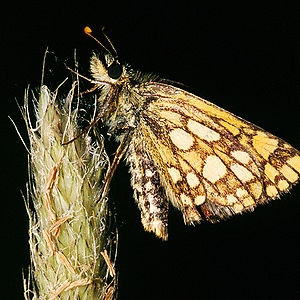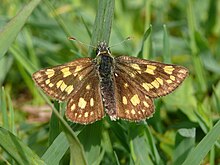Yellow-cubed thick-headed butterfly
| Yellow-cubed thick-headed butterfly | ||||||||||||
|---|---|---|---|---|---|---|---|---|---|---|---|---|

Yellow-headed thick-headed butterfly |
||||||||||||
| Systematics | ||||||||||||
|
||||||||||||
| Scientific name | ||||||||||||
| Carterocephalus palaemon | ||||||||||||
| ( Pallas , 1771) |
The yellow-cube thick-headed butterfly ( Carterocephalus palaemon , also colorful thick-headed butterfly ) is a butterfly (day butterfly ) from the family of the thick-headed butterfly (Hesperiidae).
features
The moths reach a wingspan of 22 to 28 millimeters. The upper sides of the wings have a dark brown basic color, which is broken up by orange-brown or yellow cube spots. The undersides of the wings are yellow-brown and have dark-edged, white spots. The undersides of the antennae are dark in the males and yellow in the females.
The caterpillars are about 23 millimeters long and are very slim. They have a light green basic color with dark green and white vertical stripes. Only in the last stage are they colored pure green. During the wintering phase, however, they adapt to the color of wilted leaves and are then straw-colored or leather-colored. Your head is black. They have black spots on the first segment and also on the end of the abdomen, with two larger ones fused into one elongated point at the end of the abdomen.
Similar species
- Cowslip cube butterfly ( Hamearis lucina )
- Black-spotted Golddickkopfffalter ( Carterocephalus silvicola )
Occurrence
The animals come from the northern Pyrenees through central and northern France, northern Italy ( Dolomites ) to the Arctic Circle , in central and northern Asia up to an altitude of 1,600 meters. The species is extinct in England . They live on dry and moist meadows with bushes , dry grass or on the edges of forests .
Way of life
The small and fast-flying butterflies are only found sporadically and quickly visit flowers in sunny areas. They prefer Günsel ( Ajuga spec. ) And Atlantic hare bells ( Hyacinthoides non-scripta ), but also suckle on yellow lady's slipper ( Cypripedium calceolus ).
Flight time and development
The moths fly in one generation from mid-May to June each year. The caterpillars can be found from July and after wintering until May.
Food of the caterpillars
The caterpillars feed on various grasses such as blue moor grass ( Molinia caerulea ), pipe-moor grass ( Molinia arundinaceae ) Woolly honey grass ( Holcus lanatus ), small-reed ( Calamagrostis epigejos ), Brachypodium sylvaticum ( Brachypodium sylvaticum ), Brachypodium pinnatum ( Brachypodium pinnatum ), Bromus ramosus ( Bromus ramosus ) Exceptional orchard grass ( Dactylis glomerata ), meadow foxtail ( Alopecurus pratensis ), and timothy grass ( Phleum pratense ).
development
Eggs are laid on the leaves of grass, with the eggs being laid one by one. The caterpillars prefer shady and moist places. You build a shelter by folding down a blade of grass and spinning it. This is usually the same length as the caterpillar. From there they eat half of the blade of grass at an angle. This creates a typical triangular or trapezoidal feeding pattern. They overwinter fully developed in their hiding place, reappear in March and pupate. The moths hatch in May.
supporting documents
Individual evidence
- ↑ a b c d e Heiko Bellmann : The new cosmos butterfly guide. Butterflies, caterpillars and forage plants. Franckh-Kosmos, Stuttgart 2003, ISBN 3-440-09330-1 , p. 112.
- ↑ a b c d e Tom Tolman, Richard Lewington: Die Tagfalter Europäische und Nordwestafrikas , p. 268f, Franckh-Kosmos Verlags-GmbH & Co, Stuttgart 1998, ISBN 3-440-07573-7
- ↑ Günter Ebert (Ed.): "The butterflies of Baden-Württemberg" Volume 10, supplementary volume, Ulmer Verlag, Stuttgart 2005, ISBN 3-8001-4383-6
- ↑ Manfred Koch : We identify butterflies. Volume 1: Butterfly. 4th enlarged edition. Neumann, Radebeul / Berlin 1966, DNB 457244224 , pp. 118f.
- ↑ David J. Carter: Caterpillars and Butterflies of Europe and their Forage Plants P. 30
literature
- Hans-Josef Weidemann: Butterfly: observe, determine , Naturbuch-Verlag, Augsburg 1995, ISBN 3-89440-115-X
- Günter Ebert (Ed.): The butterflies of Baden-Württemberg, Volume 2, Tagfalter II. Ulmer Verlag, Stuttgart 1993, ISBN 3-8001-3459-4
- John Still: Butterflies and Caterpillars of Europe . Mosaik Verlag Munich, Germany 1999.
- David J. Carter: Caterpillars and Butterflies of Europe and their Forage Plants . Paul Parey Publishing House, Hamburg and Berlin 1986, ISBN 3-490-13918-6 .

